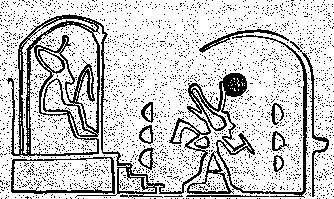|
TRANSLATIONS
Next pages:
The vero period (19) has 12 * 12 = 144 as a sign in its middle, at Ga5-19 ('fire' and 'death'). Yet honu survives. If the calendar begins with Gb8-30 at 'January 1' (i.e. July 1), then vero will come close to the end of 'May', the 5th month. Hawaiian Welo was a month around April, the 4th month. Shifting to a place south of the equator and keeping the concept, we should add 6 and have it in the 10th month. The Marquesans had veo as their 10th month. But an alternative is to keep vero in spring and change the stellar observations. The calendar of G ought to begin at 'December 1' (i.e. June 1), because then period 19 will arrive close to the end of 'April', the 4th month. Possibly the 'spear' is thrown towards the 'king' because the Pleiades disappear for a while and return in May: ... In the Hawaiian, Samoan, Tongan, Society, Marquesan, and some other islands the new year began in late November or early December with the first new Moon after the first appearance of the Pleiades in the eastern sky in the evening twilight. Late November means late 'May' on Easter Island. Notable exceptions to the general rule are found in Pukapuka and among certain tribes of New Zealand where the new year was inaugurated by the first new Moon after the Pleiades appeared on the eastern horizon just before sunrise in June. Traces of an ancient year beginning in May have been noted in the Society Islands ... In view of the almost universal prevalence of the Pleiades year throughout the Polynesian area it is surprising to find that in the South Island and certain parts of the North Island of New Zealand and in the neighboring Chatham Islands, the year began with the new Moon after the yearly morning [heliacal] rising, not of the Pleiades, but of the star Rigel in Orion. Such an important difference can be explained only on the assumption that the very first settlers ... brought the Rigel year with them ... some other land 10° south of the equator where Rigel acquired at the same time its synonymity with the zenit ... That there resulted a long and passionate struggle on the part of both the invaders and the invaded to retain their own the integrity of the sacred year of their traditions can hardly by doubted. The outcome of the conflict proved that the institution of the land was too firmly established to be changed. While some tribes retained the Rigel year in its entirety others effected a compromise by retaining the Pleiades year but commencing it in June ... Uncertainty must continue a while more. Either it was the return of the Pleiades or of Rigel or it was some other celestial event. But why not the reappearance of Antares (Ana-mua) or of Sirius (Reitaga)? What seems probable is that the 19th period indicates a time when the celestial 'person' (honu) is temporary away, out of sight like Pharaoh in the temple of 'the opener of the way':
Sirius, Reitaga, should be the primary candidate, I think.
The 'bag' (taga) should be the dark container inside which the luminary disappears for a while, as in e.g. Hanga Te Pau:
From Ga3-17 to Ga5-13 there are 61 days:
To viri in Ga5-11 there are 59 days. (Viri sounds quite similar to vero). From period 4 to period 18 there are 14 periods. Half 366 is 183, and Ga5-10 indicates, it seems, the beginning of a temporary disappearance:
If we locate Gb6-26 as the center, then we should count 182 glyphs to the left from there (in order to reach 366). It means we will go to the end of side a, to the 4th glyph from its end:
Haú at Ga8-23 has 5 feathers at left, then an empty space followed by 9 further feathers, 14 in all. The empty space indicates, it seems, the 19th period with vero. The 14th period will be the first of the 14 'feathers' in order for the 18th to be the 5th, and the 14th feather will be period 19 + 9 = 28. It is a 'feathery' season which begins with the rising fish manu kake:
8-22 and an inversion where ragi comes up means a point of turning around (120 glyphs beyond Ga4-21)
At Ga5-7 we must add 472 to our earlier number 118 (= 4 * 29.5), which means 590 or 20 * 29.5. If the sky comes up at Ga8-22, then it will go down 6 month later. Spring sun is rising there, and the stars are fading away. In Ga5-8 viri has fallen on its face.
We have determined that honu without any background extra 'fin' signs means the winter 'sun'. 70 (in contrast to 60) indicates the 'winter' half of the year. It is ruled by the moon (7).Winter 'sun' will be at left from Ga5-10:
472 - 2 * 183 - 1 (Gb6-26) = 105 (also the ordern number if the fish manu kake) = 5 * 21 = 7 * 15. This season goes from Ga5-10 to Ga8-21:
Maitaki in Ga8-21 has turned 'upside down' (an illusion, though) compared with its earlier shape (it is only the bottom 'stone' which has changed):
Before Ga8-21 there are 8 * 28 = 224 glyphs. 8 * 21 = 168, and 224 - 168 = 56 = 2 * 28. |
||||||||||||||||||||||||||||||||||||||||||||||||||||||||||||||||||||||||||||||||||||||||||||||||||||||||||||||||||||||||||||||||||||||||||||||||||||||||||||||||||||||||||||||||||||||||||||||||||||||||||||||||||||||||||||||||||||||||||||||||||||||||||||||||||||||||||||||||||||||||||||||||||||||||||||||||||||||||||||||||||||||||

































